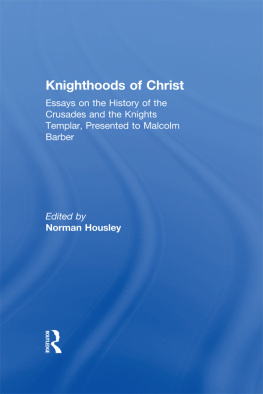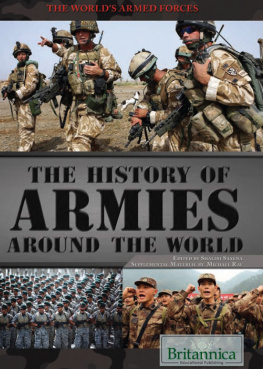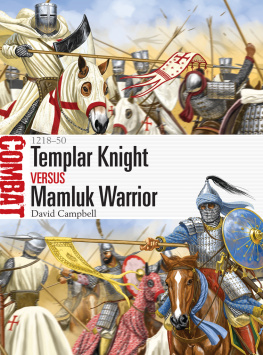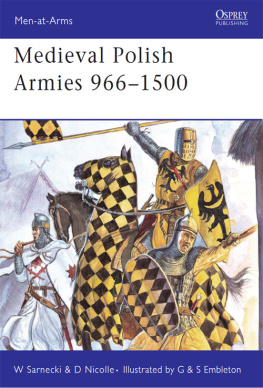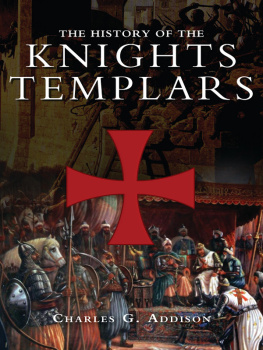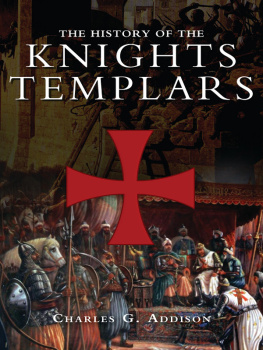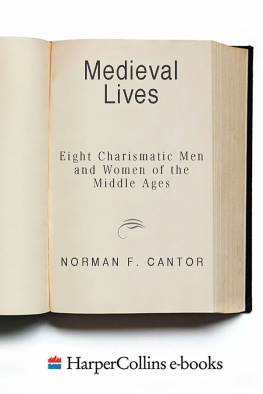THE
MEDIEVAL
SOLDIER
THE
MEDIEVAL
SOLDIER
Vesey Norman
Line drawings by Don Pottinger
Pen & Sword
MILITARY
To my goddaughters
Linnette and Joanna and my niece Joanna
First published in Great Britain in 1971
by Arthur Barker Limited
Published in this format in 2010 by
PEN & SWORD MILITARY
an imprint of
Pen & Sword Books Ltd
47 Church Street
Barnsley
South Yorkshire
S70 2AS
Copyright Vesey Norman, 1971, 2006, 2010
ISBN 978 1 84884 204 5
The right of Vesey Norman to be identified as Author
of this work has been asserted by him in accordance
with the Copyright, Designs and Patents Act 1988.
A CIP catalogue record for this book is
available from the British Library.
All rights reserved. No part of this book may be reproduced
or transmitted in any form or by any means, electronic or mechanical
including photocopying, recording or by any information storage
and retrieval system, without permission from the Publisher in writing.
Printed and bound in Great Britain
By CPI UK
Pen & Sword Books Ltd incorporates the imprints of:
Pen & Sword Aviation, Pen & Sword Maritime, Pen & Sword Military,
Wharncliffe Local History, Pen & Sword Select,
Pen & Sword Military Classics and Leo Cooper.
For a complete list of Pen & Sword titles please contact:
PEN & SWORD BOOKS LIMITED
47 Church Street, Barnsley, South Yorkshire, S70 2AS, England
E-mail: enquiries@pen-and-sword.co.uk
Website: www.pen-and-sword.co.uk
Contents
Plates
Figures
The military system of most of Western Europe during the twelfth and thirteenth centuries was feudal; that is, it was based on the holding of land in return for military service given to an overlord. The holder of the land was supported by agricultural labour and food from his peasants, in return for defending them against raiders, for defending the realm in time of war, and for administering justice to them in his courts. The three important components of the organization were; firstly, the count or earl, originally the royal district officer; secondly, the knight, the armoured cavalryman who formed the backbone of any feudal army; and thirdly, the castle. The last lies outside the scope of this book, so it is mentioned here only in relation to the services owed by knights for garrison duty in the castles of their overlords.
The system developed very unevenly. It was more advanced in France than in Germany, for instance, while in Scandinavia, although some of its features are found, others are not. It originated by the blending of the tribal military systems of the Teutonic barbarians who invaded the Roman Empire, with such features of Roman military organization as survived, for instance, in the towns of France and Italy. Long after the collapse of the Western Roman Empire its prestige lived on, and influenced enormously the thought of those who succeeded to its power.
The need to defend the frontiers of broad realms, like those of Charlemagne, at a time when travel was slow and uncertain, and the central organization poorly developed, led to the appointment of royal deputies called counts. These men were given considerable powers so that they could organize the defences of their own districts. In time of general war they had to come to the royal army with their following. Later, under Charlemagnes weaker successors, the office of count and the lands that supported it became hereditary.
Chivalry, the code which governed the life of the medieval aristocracy from the king himself down to the humblest knight, blended the concepts of honour and manhood, inherited from the dark German forests, with the gentler ideals of Christianity. The Church sanctified the oath of homage to the overlord which had originated in the oath to the leader of the Teutonic war band. The Church it was that canalized the vigorous and warlike energies of Western knighthood into the great endeavours of freeing the Holy Land from the hands of the infidel, in many ways the high point of the earlier Middle Ages.
In the first part of this book I have tried to describe the components from which feudalism and chivalry developed; the organization and ideals of the Teutonic tribes, as well as their equipment. The second part deals with the organization, arming, training, equipment, and ideals of the knight and the troops who supported him in action, in the period before the decline of feudalism changed them all into mercenary soldiers pure and simple.
A book of this type, designed to cover the greater part of Europe over a relatively long period, cannot be written without the help and advice of friends and colleagues too numerous to acknowledge individually. It would be extremely churlish, however, not to mention those who have given up a considerable amount of time to helping. I am very grateful to Mrs Leslie E. Webster, Assistant Keeper of the Department of British and Medieval Antiquities, the British Museum, for reading for me the sections on the Franks, Vikings, and Saxons in typescript and for many most helpful suggestions; to Mr E.H.H. Archibald, Deputy Head of the Department of Pictures, National Maritime Museum, Greenwich, for advice about ships; to Miss Amanda Tomlinson, Conway Librarian, the Courtauld Institute of Art, University of London, and Miss Alison Stones, now of the Department of Art History, the University of Minnesota, for advice over the dating of manuscripts; and to Mr Don Pottinger, Unicorn Pursuivant, for permission to reuse some of his drawings originally prepared for our book Warrior to Soldier 4491660 (US edition: A History of War and Weapons, 449 to 1660 ).
There are two people to whom I am particularly grateful. They are my wife, Catherine Barne, for her patience and kindness in reading and correcting my manuscript and for her many suggestions for improving it; and Mr Claude Blair, Deputy Keeper of the Department of Metalwork at the Victoria and Albert Museum, for also reading my manuscript with a kindly but critical eye, and for giving me the benefit of his unparalleled knowledge of the literary source material as well as of actual surviving arms and armour.
Mrs Hilda R.E. Davidson has very kindly allowed me to quote from her invaluable book, The Sword in Anglo-Saxon England , the passage on the swords sent to the Emperor Theodoric by the Warni. Penguin Books has also very kindly allowed me to quote from H. Mattingly, Tacitus on Britain and Germany and from M.R.B. Shaw, Joinville & Villehardouin: Chronicles of the Crusades . I am extremely grateful to Dr R. Allen Brown for drawing my attention to the passage in the Roman de Rou of Robert Wace, describing the Norman landing at Pevensey.
In a work of this nature the writer must depend heavily on the work of his predecessors in the field, and I should like to acknowledge my debt to all those whose books appear in the bibliography at the end of the book.
Of the great German races that overran western I Europe in the fifth and sixth centuries, the Franks in the north and the Lombards in the south left the greatest marks. The Visigoths in Spain, always few in number and irrevocably divided by their religion from their subject people, were unable to form a united kingdom and succumbed to the Saracen advance early in the eighth century. For similar reasons the Vandals failed to secure their hold of the North African coast line. They added to their difficulties by their harsh treatment of the natives and persecuting all not of the Arian faith.


